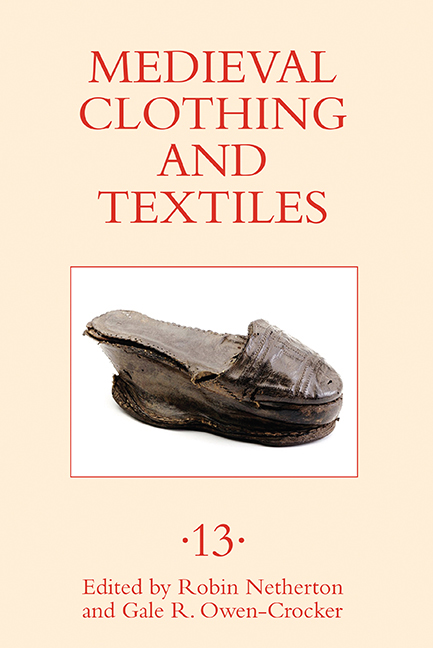Book contents
- Frontmatter
- Contents
- Illustrations
- Tables
- Contributors
- Preface
- 1 The Significance of Dress in the Bayeux Tapestry
- 2 How Long Is a Launce? Units of Measure for Cloth in Late Medieval Britain
- 3 Robes, Turbans, and Beards: “Ethnic Passing” in Decameron 10.9
- 4 Calciamentum: Footwear in Late Medieval Lucca
- 5 “Bene in ordene et bene ornata“: Eleonora d’Aragona’s Description of Her Suite of Rooms in a Roman Palace of the Late Fifteenth Century
- 6 The Lübeck Wappenröcke: Distinctive Style in Fifteenth-Century German Fabric Armor
- Recent Books of Interest
- Contents of Previous Volumes
5 - “Bene in ordene et bene ornata“: Eleonora d’Aragona’s Description of Her Suite of Rooms in a Roman Palace of the Late Fifteenth Century
Published online by Cambridge University Press: 12 August 2020
- Frontmatter
- Contents
- Illustrations
- Tables
- Contributors
- Preface
- 1 The Significance of Dress in the Bayeux Tapestry
- 2 How Long Is a Launce? Units of Measure for Cloth in Late Medieval Britain
- 3 Robes, Turbans, and Beards: “Ethnic Passing” in Decameron 10.9
- 4 Calciamentum: Footwear in Late Medieval Lucca
- 5 “Bene in ordene et bene ornata“: Eleonora d’Aragona’s Description of Her Suite of Rooms in a Roman Palace of the Late Fifteenth Century
- 6 The Lübeck Wappenröcke: Distinctive Style in Fifteenth-Century German Fabric Armor
- Recent Books of Interest
- Contents of Previous Volumes
Summary
Eleonora d’Aragona (1450–93), the eldest daughter of King Ferdinand I of Naples and his first wife Isabella of Chiaromonte, was married by proxy in August 1472 to Ercole d’Este, who had just become duke of Ferrara. Over a decade earlier her grandfather, Alfonso V of Aragon and I of Naples (1396–1458), had agreed with Duke Francesco Sforza of Milan to marry her to one of the duke's sons, Sforza Maria Sforza (1451–79), who was later made duke of Bari. This marriage, which was not consummated, took place in Naples in 1465. Following the death of the Duke of Milan in 1466, however, Eleonora remained in Naples pending various disagreements over the terms of her dowry between her father King Ferdinand and her brother-in-law the new duke of Milan, Gian Galeazzo Sforza.
By 1471 Ferdinand managed to come to an accord with Milan: Sforza Maria Sforza was permitted to retain the duchy of Bari, and his marriage to Eleonora was officially annulled by Pope Sixtus IV. In the complicated politics of the Italian peninsula Ferdinand then sought to ally Naples with Ferrara and its new duke Ercole d’Este, a condottiere (mercenary general) with whom Eleonora must have been acquainted, since he had been a member of the Neapolitan court in the service of the king between 1445 and 1460. The marriage was therefore both socially acceptable and also a shrewd political move for both Ferrara and Naples. Eleonora's marriage as a princess of Naples represented an alliance between the kingdom of Naples and the duchy of Ferrara. As a consequence, great political significance would have been placed on the type of welcome she received at Rome, Siena, and Florence, where she and her entourage stopped on the journey north to Ferrara in the late spring of 1473. Note would have been taken of the reception she was accorded, as well as the quality of the accommodation, banquets, and entertainments provided for her benefit. Eleonora's letters home during her journey contain detailed descriptions of her surroundings and a record of the dignitaries she met on what amounted to a state visit.
- Type
- Chapter
- Information
- Medieval Clothing and Textiles 13 , pp. 107 - 120Publisher: Boydell & BrewerPrint publication year: 2017

